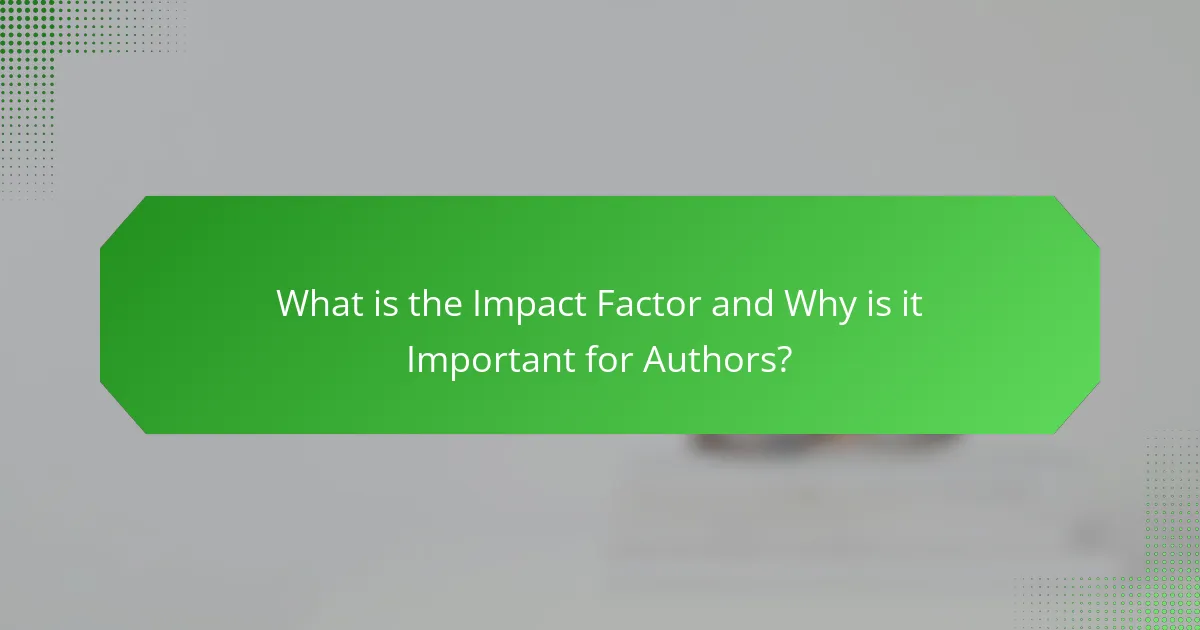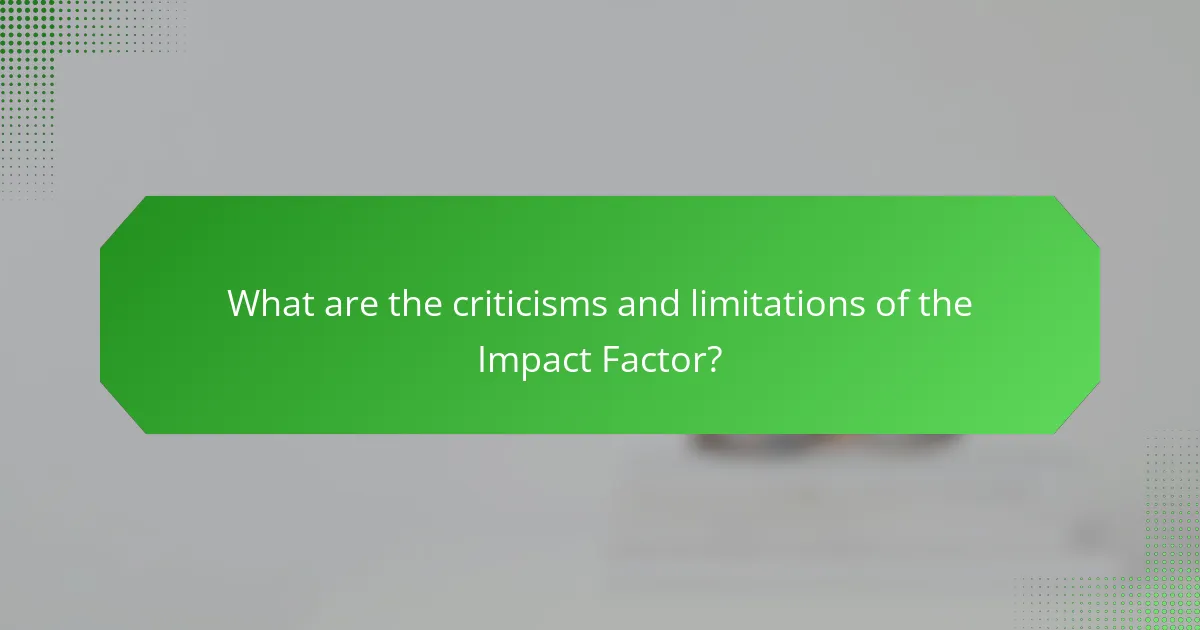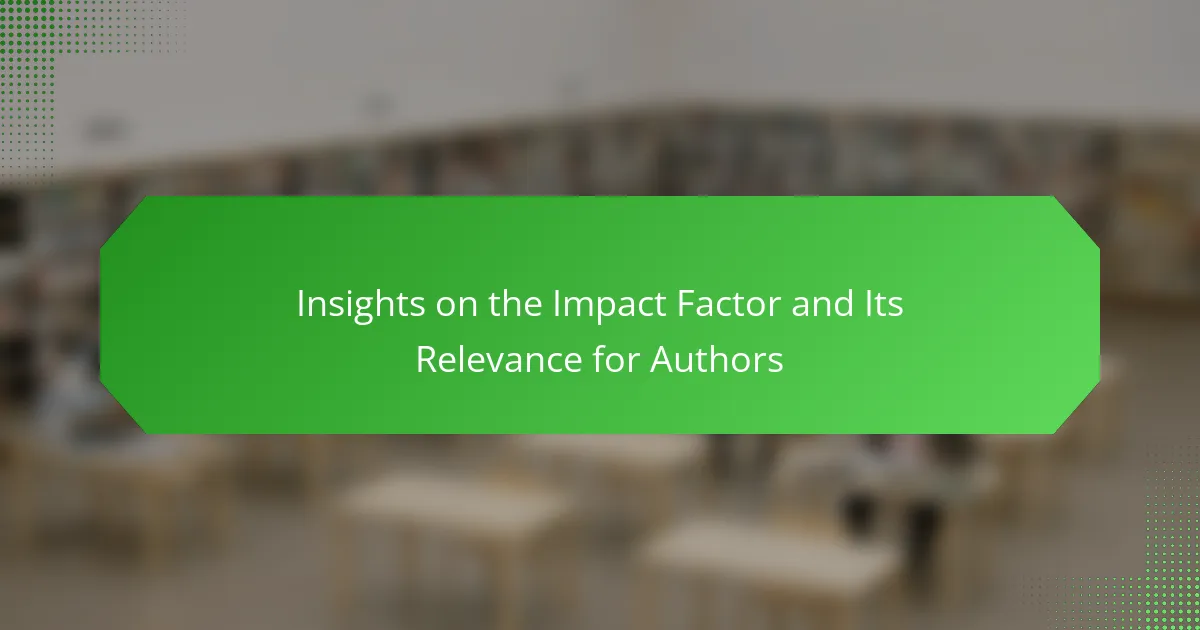The Impact Factor is a quantitative measure that reflects the average number of citations to articles published in a specific academic journal, calculated using citation data from the previous two years. This metric serves as a key indicator of a journal’s prestige and relevance within its field, influencing authors’ decisions on where to submit their work. A higher Impact Factor often correlates with increased visibility and credibility for authors, which can enhance their academic standing and career opportunities. However, the Impact Factor also faces criticism for its limitations, including potential biases and the emphasis on citation quantity over research quality. This article provides insights into the significance of the Impact Factor for authors, its implications for career advancement, and the ongoing debate surrounding its effectiveness as a measure of research quality.

What is the Impact Factor and Why is it Important for Authors?
The Impact Factor is a quantitative measure reflecting the average number of citations to articles published in a specific journal. It is calculated by dividing the number of citations in a given year to articles published in the previous two years by the total number of articles published in those two years. This metric helps authors assess the relative importance of a journal within its field. A higher Impact Factor often indicates a more prestigious journal, which can enhance an author’s visibility and credibility. Authors often consider the Impact Factor when deciding where to submit their work. Journals with higher Impact Factors tend to attract more readership, increasing the likelihood of citations. This can be crucial for career advancement, grant applications, and academic recognition.
How is the Impact Factor calculated?
The Impact Factor is calculated by dividing the number of citations in a given year to articles published in the previous two years by the total number of articles published in those two years. For example, if a journal has 100 citations in 2022 for articles published in 2020 and 2021, and it published 50 articles in those years, the Impact Factor would be 2.0. This calculation provides a measure of the journal’s influence and is widely used in academia. The formula is: Impact Factor = Citations in Year X to articles published in Years X-1 and X-2 / Total articles published in Years X-1 and X-2.
What metrics are used in the calculation of the Impact Factor?
The metrics used in the calculation of the Impact Factor include the number of citations and the number of articles published. The Impact Factor is defined as the total number of citations received in a specific year by articles published in the previous two years. This metric is divided by the total number of articles published in those two years. For example, if a journal has 100 citations in 2022 for articles published in 2020 and 2021, and published 50 articles in those years, the Impact Factor would be 2.0. This calculation helps assess the journal’s influence and relevance in its field.
How often is the Impact Factor updated?
The Impact Factor is updated annually. It is typically released in June each year. This update reflects citation data from the previous two years. The data is compiled by Clarivate Analytics. The update process involves rigorous analysis of journal citations. This ensures that the Impact Factor remains a relevant metric.
What role does the Impact Factor play in academic publishing?
The Impact Factor serves as a measure of the average number of citations to articles published in a journal. It influences the perception of a journal’s quality and prestige in academic publishing. Higher Impact Factors often attract more submissions from researchers. This can lead to a greater visibility of published work. Additionally, funding agencies and institutions may consider Impact Factors in evaluating research output. The metric is calculated annually based on citation data from the previous two years. Therefore, it reflects the journal’s influence within its field. Many researchers aim to publish in high Impact Factor journals to enhance their academic reputation.
How does the Impact Factor influence journal selection for authors?
The Impact Factor significantly influences journal selection for authors. It serves as a metric indicating the average number of citations to articles published in a journal. Authors often prefer journals with higher Impact Factors, as this is associated with greater visibility and credibility. A higher Impact Factor can enhance the perceived quality of an author’s work. This preference is supported by studies showing that articles in high-Impact Factor journals receive more citations. Consequently, authors may prioritize submitting to these journals to increase their chances of publication success and impact within their field.
What are the implications of the Impact Factor on research visibility?
The Impact Factor significantly influences research visibility. It serves as a metric that reflects the average number of citations to articles published in a journal. Higher Impact Factors often correlate with increased visibility and credibility of the research published within those journals. Researchers tend to prefer publishing in journals with higher Impact Factors to enhance the reach of their work. Studies indicate that articles in high-impact journals receive more citations, which boosts the authors’ professional profiles. Consequently, this can lead to greater opportunities for funding and collaboration. Thus, the Impact Factor plays a crucial role in shaping the visibility and impact of research in the academic community.

How does the Impact Factor affect an author’s career?
The Impact Factor significantly influences an author’s career by affecting their publication opportunities and perceived credibility. A higher Impact Factor often correlates with prestigious journals. Authors published in these journals gain visibility and recognition in their field. This recognition can lead to increased citations of their work. More citations enhance an author’s reputation and academic standing. Additionally, funding agencies and institutions often consider Impact Factor when evaluating research quality. Consequently, authors with publications in high Impact Factor journals may secure better job placements and promotions. Overall, the Impact Factor plays a crucial role in shaping an author’s professional trajectory and success.
What are the benefits of publishing in high Impact Factor journals?
Publishing in high Impact Factor journals enhances visibility and credibility. These journals are widely read and cited, increasing the reach of the research. Higher citation rates often lead to greater recognition in the academic community. This recognition can enhance career prospects for authors. Additionally, articles in these journals are typically subject to rigorous peer review. This process ensures higher quality and reliability of published research. Consequently, research published in such journals is often considered more prestigious. This prestige can attract funding and collaboration opportunities. Overall, publishing in high Impact Factor journals significantly benefits authors’ professional profiles and research impact.
How can a high Impact Factor enhance an author’s reputation?
A high Impact Factor can significantly enhance an author’s reputation. It indicates that the author’s work is published in a journal that is frequently cited. This frequent citation suggests that the research is influential and relevant in its field. When an author publishes in high Impact Factor journals, it reflects their credibility and expertise. This can lead to increased visibility among peers and potential collaborations. Additionally, a strong publication record in reputable journals can improve an author’s chances for funding and academic positions. Overall, a high Impact Factor serves as a marker of quality and scholarly impact, contributing positively to an author’s professional standing.
What are the potential drawbacks of focusing solely on Impact Factor?
Focusing solely on Impact Factor can lead to several drawbacks. It may encourage authors to prioritize quantity over quality in their research. This can result in publishing less rigorous studies to achieve higher citation counts. Additionally, it overlooks the diversity of scholarly contributions that do not fit traditional metrics. Some important research may be published in lower-impact journals. This narrow focus can also create pressure on researchers to engage in citation manipulation. Ultimately, it may skew the perception of a researcher’s true impact and contributions. Studies show that reliance on Impact Factor can misrepresent the value of research in fields with different citation practices.
How do authors leverage the Impact Factor in their submissions?
Authors leverage the Impact Factor by selecting journals with higher ratings for their submissions. A higher Impact Factor often indicates a journal’s prestige and influence in the field. Authors believe that publishing in such journals enhances their visibility and credibility. They may tailor their manuscripts to align with the journal’s focus, increasing the likelihood of acceptance. Additionally, authors often cite the journal’s Impact Factor in their cover letters to emphasize the significance of their work. Research shows that articles in higher Impact Factor journals receive more citations, further motivating authors to target these publications. Thus, the Impact Factor serves as a strategic tool in the submission process.
What strategies can authors use to choose the right journal based on Impact Factor?
Authors can use several strategies to choose the right journal based on Impact Factor. First, they should identify journals within their specific field. This ensures relevance and increases the chances of acceptance. Next, authors should compare the Impact Factors of these journals. Higher Impact Factors often indicate wider readership and citation potential.
Authors should also consider the journal’s scope and audience. A journal with a closely aligned focus will likely appreciate the submitted work more. Additionally, examining the journal’s acceptance rate can provide insights into its competitiveness.
Authors can read recent articles published in candidate journals. This helps assess the quality and relevance of the journal. Consulting tools like Journal Citation Reports can help authors find and compare Impact Factors. Finally, seeking advice from colleagues or mentors can provide valuable perspectives on journal selection.
How can authors effectively communicate their work’s relevance to high Impact Factor journals?
Authors can effectively communicate their work’s relevance to high Impact Factor journals by clearly articulating the significance of their research. They should highlight how their findings address critical gaps in existing literature. This includes presenting compelling data that supports their claims. Authors must demonstrate the broader implications of their work for the field. They should also align their research objectives with the journal’s scope and audience. Using precise language and structured abstracts can enhance clarity. Engaging with current trends and citing relevant studies strengthens the argument for relevance. Lastly, addressing potential applications of the research can attract journal interest.

What are the criticisms and limitations of the Impact Factor?
The Impact Factor has several criticisms and limitations. It primarily measures citation frequency, which may not reflect the quality of research. Many scholars argue it encourages quantity over quality in publications. The calculation method can be manipulated by journals, leading to inflated scores. Additionally, it is biased towards certain disciplines, favoring fields with higher citation rates. The Impact Factor also overlooks the significance of articles that may be influential but receive fewer citations. Furthermore, it does not account for the context of citations, which can misrepresent an article’s impact. These limitations highlight the need for alternative metrics to assess research quality.
Why do some scholars argue against the use of Impact Factor?
Some scholars argue against the use of Impact Factor because it does not accurately reflect the quality of individual articles. Impact Factor primarily measures journal citation rates, not the significance of specific research. This can lead to a misrepresentation of a researcher’s contributions. Additionally, it encourages publishing in high-impact journals rather than promoting innovative or niche research. Critics point out that the metric can be manipulated through citation practices. A study by Seglen (1997) highlighted that the Impact Factor can be influenced by self-citations, further questioning its reliability. Furthermore, it does not account for variations in citation practices across disciplines. These factors collectively undermine the validity of Impact Factor as a sole measure of research quality.
What alternative metrics exist to evaluate journal quality?
Alternative metrics to evaluate journal quality include the h-index, article-level metrics, and Altmetric scores. The h-index measures the productivity and citation impact of a journal’s published articles. Article-level metrics assess the influence of individual articles based on citations, downloads, and social media mentions. Altmetric scores track the online attention an article receives, including mentions in news outlets and blogs. These metrics provide a broader view of a journal’s impact beyond traditional citation counts. Research shows that these alternative metrics can complement traditional measures like the Impact Factor, offering a more comprehensive evaluation of journal quality.
How can reliance on Impact Factor distort research priorities?
Reliance on Impact Factor can distort research priorities by incentivizing quantity over quality in scientific publishing. Researchers may prioritize publishing in high-impact journals rather than pursuing innovative or niche areas of study. This focus can lead to a homogenization of research topics, as popular fields receive more attention. Consequently, important but less commercially viable research may be neglected. A study by Vanclay (2019) highlights that reliance on Impact Factor can create a bias against interdisciplinary research, limiting scientific progress. Additionally, researchers might engage in “salami slicing,” where they break down studies into smaller parts to increase publication count. This behavior skews the true impact and relevance of research findings.
What is the future of the Impact Factor in academic publishing?
The future of the Impact Factor in academic publishing is likely to see significant changes. The traditional reliance on Impact Factor is being questioned. Many scholars advocate for alternative metrics that reflect broader research impact. These alternatives include article-level metrics and altmetrics. They provide a more comprehensive view of research influence. The push for open access publishing is also gaining momentum. This shift may reduce the emphasis on traditional journal rankings. Increasingly, funding agencies and institutions are prioritizing diverse metrics. This trend indicates a potential decline in the Impact Factor’s dominance. The evolving landscape suggests that the Impact Factor may become one of many evaluation tools.
How are emerging trends influencing the perception of Impact Factor?
Emerging trends are reshaping the perception of Impact Factor by emphasizing alternative metrics. Traditional Impact Factor primarily measures journal citation frequency. However, researchers now value broader indicators of research impact, such as Altmetrics. These metrics account for social media mentions, policy documents, and public engagement.
The rise of open access publishing is also influencing perceptions. Open access articles often receive higher visibility and citation rates. This shift prompts a reevaluation of the significance of Impact Factor alone. Additionally, interdisciplinary research is gaining traction. This trend challenges the relevance of discipline-specific Impact Factors.
A study by Haustein et al. (2016) highlights that researchers increasingly consider diverse impact measures. This indicates a growing recognition that Impact Factor may not fully capture research influence. As a result, the academic community is moving towards a more holistic understanding of research impact.
What changes are being proposed to improve journal evaluation metrics?
Proposed changes to improve journal evaluation metrics include enhancing transparency in the peer review process. This change aims to build trust in the evaluation system. Another proposal is to incorporate diverse metrics beyond the traditional Impact Factor. These metrics may include article-level citations and altmetrics. Additionally, there is a push for more inclusive criteria that consider the journal’s overall contribution to the field. These changes are backed by recent discussions in scholarly communication forums, highlighting the need for a more holistic approach to evaluation.
What practical tips can authors follow regarding the Impact Factor?
Authors should prioritize publishing in journals with a high Impact Factor. A high Impact Factor indicates greater visibility and citation potential. Authors can enhance their research’s reach by selecting journals that align with their field. They should also consider the journal’s audience and scope. Submitting to well-regarded journals can lead to higher quality peer reviews. Authors should stay informed about recent trends in their field to align their work with current interests. Networking with other researchers can provide insights into journal reputation. Lastly, authors should focus on the quality and originality of their research to increase its impact, regardless of the journal’s Impact Factor.
How can authors balance Impact Factor considerations with research integrity?
Authors can balance Impact Factor considerations with research integrity by prioritizing high-quality, ethical research practices. They should focus on conducting rigorous studies that contribute meaningful insights to their field. Transparency in methodology and results enhances credibility and aligns with the principles of integrity. Choosing reputable journals that emphasize ethical standards helps maintain this balance. Engaging with peer review processes ensures that research is scrutinized for quality and validity. Ultimately, the commitment to integrity can lead to a positive impact on the author’s reputation, which may indirectly influence future Impact Factor metrics.
What resources are available for authors to understand Impact Factor better?
Authors can access various resources to understand Impact Factor better. Key resources include academic journals that discuss the concept and its implications. The Journal Citation Reports (JCR) provides detailed metrics and explanations of Impact Factor calculations. Websites like Clarivate Analytics offer guides on interpreting Impact Factors. Additionally, scholarly articles and books on bibliometrics delve into the significance of Impact Factor in research evaluation. Online courses and webinars from academic institutions also cover this topic extensively. These resources collectively enhance authors’ comprehension of Impact Factor and its relevance in academia.
The main entity of this article is the Impact Factor, a quantitative measure that reflects the average number of citations to articles published in a specific journal. The article provides a comprehensive overview of the Impact Factor, including its calculation, significance for authors, and its role in academic publishing. It discusses how a higher Impact Factor can enhance an author’s visibility and credibility, influence journal selection, and affect career advancement. Additionally, the article addresses criticisms and limitations of the Impact Factor, explores alternative metrics for evaluating journal quality, and offers practical tips for authors on leveraging this metric while maintaining research integrity.


